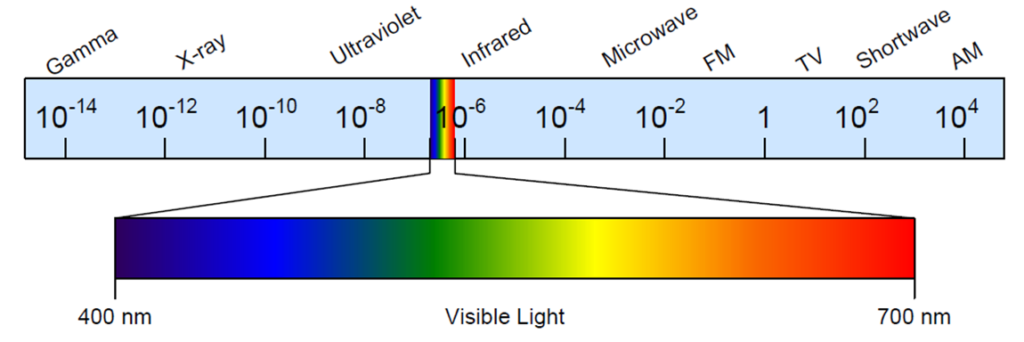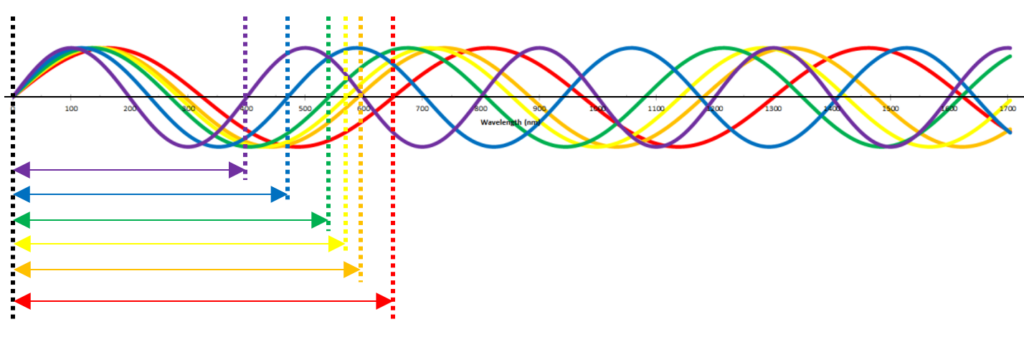
The electromagnetic spectrum is a continuum of all electromagnetic waves arranged by their frequency and wavelength. Electromagnetic waves are oscillating electric and magnetic fields that travel through space at the speed of light (approximately 299,792,458 meters per second in a vacuum). These waves do not require a medium for propagation, making them capable of traveling through empty space.


Key Regions of the Electromagnetic Spectrum
The electromagnetic spectrum is divided into several regions, each with its unique characteristics and applications. The following regions of the electromagnetic spectrum are identified by their range of wavelength (see above figures).
a. Radio Waves:
- Longest wavelengths and lowest frequencies.
- Used in radio broadcasting, telecommunications, and radar technology.
b. Microwaves:
- Slightly shorter wavelengths and higher frequencies compared to radio waves.
- Used in microwave ovens, satellite communication, and radar systems.
c. Infrared Radiation:
- Lies just beyond the visible light spectrum.
- Used in heat sensing, night vision, and remote controls.
d. Visible Light:
- The only portion of the spectrum visible to the human eye.
- Comprises a range of colors with different wavelengths (e.g., red, blue, green).
- Essential for vision and photography.
e. Ultraviolet Radiation:
- Shorter wavelengths and higher frequencies than visible light.
- Used in sterilization, fluorescence, and astronomy.
f. X-Rays:
- Very high frequencies and short wavelengths.
- Utilized in medical imaging (X-ray radiography), airport security, and material analysis.
g. Gamma Rays:
- Shortest wavelengths and highest frequencies in the spectrum.
- Produced by nuclear reactions and used in cancer treatment (gamma knife) and astrophysical research.
Using the Electromagnetic Spectrum
The electromagnetic spectrum is an indispensable tool in various fields:
- Communications: Radio waves and microwaves enable wireless communication, including cell phones, television broadcasting, and Wi-Fi networks.
- Medicine: X-rays and gamma rays are used in medical diagnostics, such as X-ray imaging, CT scans, and radiation therapy for cancer treatment.
- Astronomy: Telescopes and observatories use a wide range of electromagnetic waves to study celestial objects, including visible light, infrared, and radio waves.
- Remote Sensing: Satellites equipped with sensors in various regions of the spectrum monitor Earth’s surface, track weather patterns, and assess environmental changes.
- Security: X-ray scanners at airports and other security checkpoints help detect hidden objects or materials.
- Entertainment: Visible light and infrared technologies are used in cameras, camcorders, and entertainment displays.
- Military and Defense: Radar systems, infrared night vision, and communication technologies are vital for military applications.
Our focus is on the use of certain regions of the Electromagnetic Spectrum to detect, identify, classify and track objects and materials. We do so by taking advantage of the fact that the composition and properties of materials determine how they interact with Ultraviolet, Visible and/or Infrared light. The next article is titled “Identifying Materials by their Spectral Signatures”. This is a key concept with respect to understanding Spectral Imaging.

